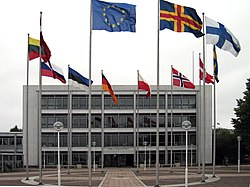Politics of Åland
This article needs additional citations for verification. (March 2010) |
 |
|---|
Politics of the Åland Islands (Template:Lang-sv) take place within a parliamentary system of representative democracy. Åland is an autonomous, demilitarised, and unilingually Swedish-speaking region of Finland. Executive power is exercised by the Lantråd (premier), who leads the Government of Åland (Landskapsregering) under the supervision of the Parliament of Åland (Lagting).
The political framework is defined by the Act on Åland Autonomy and international agreements, which guarantee Åland’s autonomy and demilitarised status. The autonomous government handles responsibilities similar to those of Finland’s regional councils.
History
[edit]In 1634, Åland was incorporated into Åbo and Björneborg County as part of administrative reforms initiated by Count Axel Oxenstierna. In 1809, Sweden ceded Finland, including Åland, to the Russian Empire following the Napoleonic Wars. When Finland declared independence in 1917, Åland became part of the new Finnish state.
During the Finnish Civil War in 1918, Russian troops remained on the islands, causing unrest. In response, Sweden occupied the territory, and 7,135 residents (from a total population of around 22,500) signed a petition requesting union with Sweden. German forces also intervened during this period. Finnish media discussed a possible territorial exchange—Åland to Sweden in return for parts of Norrbotten and Västerbotten—but Sweden rejected the proposal.
In 1921, the issue was brought before the League of Nations, which ruled that Åland would remain under Finnish sovereignty. However, the League also mandated protections for the Swedish language, the continuation of demilitarisation, and the granting of autonomy in peacetime.[1]
Autonomy
[edit]Åland has its own flag, has issued postage stamps since 1984, maintains a local police force, and is represented in the Nordic Council. Male residents are exempt from conscription. Parliamentarism has been the custom since 1988.
Although Åland remains under Finnish sovereignty, it exercises extensive self-government and elects one representative to the Parliament of Finland. Since the 1920s, the central political issue has been the preservation and development of autonomy.[2]
Executive branch
[edit]
Legislative branch
[edit]The Parliament of Åland (Lagtinget, meaning "law assembly") is a unicameral legislature with 30 members, elected every four years by proportional representation.
Political parties and elections
[edit]Until the late 1970s, Ålandic politics were dominated by prominent individuals. A structured party system developed later. Major political parties since 1979 include:
The political left is relatively weak compared to other Nordic regions.[2]
Local government
[edit]Åland is divided into 16 municipalities (kommuner). These local governments manage services such as education, healthcare, planning, and infrastructure.
See also
[edit]- Politics of Finland
- Ting
- Swedish Assembly of Finland (Folktinget)
References
[edit]- ^ "The Åland Agreement in the Council of the League of Nations 1921, Minutes of the Seventeenth Meeting of the Council, June 27th" (archived)
- ^ a b Arter, David (2022). "Personal representation or party representation? Elections in the autonomous Åland Islands". Regional & Federal Studies: 1–14. doi:10.1080/13597566.2022.2047940. ISSN 1359-7566. S2CID 248113785.
External links
[edit]- Lagtinget – Official site (archived)
- Landskapsregeringen – Official site (archived)
- Act on Åland Autonomy – Text of the autonomy law (archived)
| Office | Name | Party | Since |
|---|
| History | |||||||
|---|---|---|---|---|---|---|---|
| Geography |
| ||||||
| Politics | |||||||
| Economy | |||||||
| Culture | |||||||
